Psychological and educational interventions for preventing falls in older people living in the community
- PMID: 39360568
- PMCID: PMC11448480
- DOI: 10.1002/14651858.CD013480.pub2
Psychological and educational interventions for preventing falls in older people living in the community
Abstract
Background: Older adults are at increased risk of both falls and fall-related injuries. Falls have multiple causes and many interventions exist to try and prevent them, including educational and psychological interventions. Educational interventions aim to increase older people's understanding of what they can do to prevent falls and psychological interventions can aim to improve confidence/motivation to engage in activities that may prevent falls. This review is an update of previous evidence to focus on educational and psychological interventions for falls prevention in community-dwelling older people.
Objectives: To assess the benefits and harms of psychological interventions (such as cognitive behavioural therapy; with or without an education component) and educational interventions for preventing falls in older people living in the community.
Search methods: We searched CENTRAL, MEDLINE, Embase, four other databases, and two trials registries to June 2023. We also screened reference lists and conducted forward-citation searching.
Selection criteria: We included randomised controlled trials of community-dwelling people aged 60 years and older exploring the effectiveness of psychological interventions (such as cognitive behavioural therapy) or educational interventions (or both) aiming to prevent falls.
Data collection and analysis: We used standard methodological procedures expected by Cochrane. Our primary outcome was rate of falls. We also explored: number of people falling; people with fall-related fractures; people with falls that required medical attention; people with fall-related hospital admission; fall-related psychological outcomes (i.e. concerns about falling); health-related quality of life; and adverse events.
Main results: We included 37 studies (six on cognitive behavioural interventions; three on motivational interviewing; three on other psychological interventions; nine on multifactorial (personalised) education; 12 on multiple topic education; two on single topic education; one with unclear education type; and one psychological plus educational intervention). Studies randomised 17,478 participants (71% women; mean age 73 years). Most studies were at high or unclear risk of bias for one or more domains. Cognitive behavioural interventions Cognitive behavioural interventions make little to no difference to the number of fallers (risk ratio (RR) 0.92, 95% confidence interval (CI) 0.82 to 1.02; 4 studies, 1286 participants; low-certainty evidence), and there was a slight reduction in concerns about falling (standardised mean difference (SMD) -0.30, 95% CI -0.42 to -0.19; 3 studies, 1132 participants; low-certainty evidence). The evidence is very uncertain or missing about the effect of cognitive behavioural interventions on other outcomes. Motivational interviewing The evidence is very uncertain about the effect of motivational interviewing on rate of falls, number of fallers, and fall-related psychological outcomes. No evidence is available on the effects of motivational interviewing on people experiencing fall-related fractures, falls requiring medical attention, fall-related hospital admission, or adverse events. Other psychological interventions The evidence is very uncertain about the effect of health coaching on rate of falls, number of fallers, people sustaining a fall-related fracture, or fall-related hospital admission; the effect of other psychological interventions on these outcomes was not measured. The evidence is very uncertain about the effect of health coaching, guided imagery, and mental practice on fall-related psychological outcomes. The effect of other psychological interventions on falls needing medical attention or adverse events was not measured. Multifactorial education Multifactorial (personalised) education makes little to no difference to the rate of falls (rate ratio 0.95, 95% CI 0.77 to 1.17; 2 studies, 777 participants; low-certainty evidence). The effect of multifactorial education on people experiencing fall-related fractures was very imprecise (RR 0.66, 95% CI 0.29 to 1.48; 2 studies, 510 participants; low-certainty evidence), and the evidence is very uncertain about its effect on the number of fallers. There was no evidence for other outcomes. Multiple component education Multiple component education may improve fall-related psychological outcomes (MD -2.94, 95% CI -4.41 to -1.48; 1 study, 459 participants; low-certainty evidence). However, the evidence is very uncertain about its effect on all other outcomes. Single topic education The evidence is very uncertain about the effect of single-topic education on rate of falls, number of fallers, and people experiencing fall-related fractures. There was no evidence for other outcomes. Psychological plus educational interventions Motivational interviewing/coaching combined with multifactorial (personalised) education likely reduces the rate of falls (although the size of this effect is not clear; rate ratio 0.65, 95% CI 0.43 to 0.99; 1 study, 430 participants; moderate-certainty evidence), but makes little to no difference to the number of fallers (RR 0.93, 95% CI 0.76 to 1.13; 1 study, 430 participants; high-certainty evidence). It probably makes little to no difference to falls-related psychological outcomes (MD -0.70, 95% CI -1.81 to 0.41; 1 study, 353 participants; moderate-certainty evidence). There were no adverse events detected (1 study, 430 participants; moderate-certainty evidence). There was no evidence for psychological plus educational intervention on other outcomes.
Authors' conclusions: The evidence suggests that a combined psychological and educational intervention likely reduces the rate of falls (but not fallers), without affecting adverse events. Overall, the evidence for individual psychological interventions or delivering education alone is of low or very-low certainty; future research may change our confidence and understanding of the effects. Cognitive behavioural interventions may improve concerns about falling slightly, but this may not help reduce the number of people who fall. Certain types of education (i.e. multiple component education) may also help reduce concerns about falling, but not necessarily reduce the number of falls. Future research should adhere to reporting standards for describing the interventions used and explore how these interventions may work, to better understand what could best work for whom in what situation. There is a particular dearth of evidence for low- to middle-income countries.
Trial registration: ClinicalTrials.gov NCT01778972 NCT03824015 NCT01358032 NCT02128789 NCT02333994 NCT02774889 NCT01858493 NCT00877058 NCT02629666 NCT01528761 NCT04997681 NCT03189342 NCT04759690 NCT03147625 NCT00298558 NCT03190460 NCT03417635 NCT02645006 NCT05689554 NCT04313062 NCT04717258 NCT05192408.
Copyright © 2024 The Cochrane Collaboration. Published by John Wiley & Sons, Ltd.
Conflict of interest statement
JU: none.
HM: none.
AD is Principal Investigator for another systematic review (published in 2022) exploring the use of shock‐absorbing flooring in hospitals and care homes for fall‐related injury prevention, funded by National Institute for Health Research (NIHR Health Technology Assessment, 17/148/11 – The SAFEST Review: The Shock‐Absorbing Flooring Effectiveness SysTematic Review including older adults and staff in care settings).
MP: none.
Figures

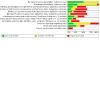
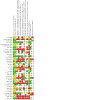



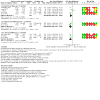

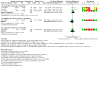

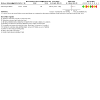



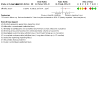
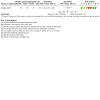
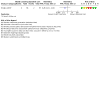
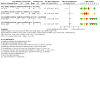
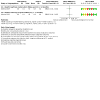
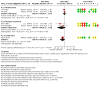

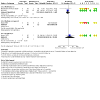
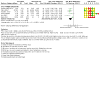
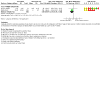



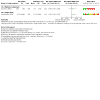



Update of
- doi: 10.1002/14651858.CD013480
References
References to studies included in this review
Alipour 2020 {published data only}
-
- Alipour N, Dastoorpour M, Araban M. Effect of educational intervention on fear of falling in the elderly people: a randomized cluster trial. Journal of Education and Community Health 2020;7(3):145-51. [DOI: 10.29252/jech.7.3.145] - DOI
Arkkukangas 2020 {published data only}
-
- Arkkukangas M, Söderlund A, Eriksson S, Johansson AC. Fall preventive exercise with or without behavior change support for community-dwelling older adults: a randomized controlled trial with short-term follow-up. Journal of Geriatric Physical Therapy (2001) 2019;42(1):9-17. [DOI: 10.1519/JPT.0000000000000129] - DOI - PubMed
-
- Arkkukangas M, Tuvemo Johnson S, Hellström K, Anens E, Tonkonogi M, Larsson U. Fall-prevention exercises with or without behavior change support for community-dwelling older adults: a 2-year follow-up of a randomized controlled trial. Journal of Aging and Physical Activity 2020;28(1):34-41. [DOI: 10.1123/japa.2019-0116] - DOI - PubMed
-
- Arkkukangas M, Tuvemo Johnson S, Hellström K, Söderlund A, Eriksson S, Johansson AC. A feasibility study of a randomised controlled trial comparing fall prevention using exercise with or without the support of motivational interviewing. Preventive Medicine Reports 2015;2:134-40. [DOI: 10.1016/j.pmedr.2015.01.007] - DOI - PMC - PubMed
-
- Johnson ST, Anens E, Johansson AC, Hellström K. The Otago Exercise Program with or without motivational interviewing for community-dwelling older adults: a 12-month follow-up of a randomized, controlled trial. Journal of Applied Gerontology 2021;40(3):289-99. [DOI: 10.1177/07334648209026] - DOI - PMC - PubMed
Audsley 2020 {published data only}
-
- Audsley S, Orton E, Pip L, Denise K. Keeping adults physically active after falls management exercise programmes end. Physiotherapy 2020;107(Suppl 1):e20-1. [DOI: 10.1016/j.physio.2020.03.030] - DOI
-
- NCT03824015. Keeping adults physically active feasibility study (KAPA). clinicaltrials.gov/ct2/show/NCT03824015 (first received 31 January 2019).
Barker 2019 {published data only}
-
- ACTRN12614000336684. RESPOND – a patient-centred program to prevent secondary falls in older people presenting to the emergency department (ED) with a fall: protocol for a multi-centre randomised controlled trial. anzctr.org.au/ACTRN12614000336684.aspx (first received 21 March 2014).
-
- Barker A, Cameron P, Flicker L, Arendts G, Brand C, Etherton-Beer C, et al. Evaluation of RESPOND, a patient-centred program to prevent falls in older people presenting to the emergency department with a fall: a randomised controlled trial. PLOS Medicine 2019;16(5):e1002807. [DOI: 10.1371/journal.pmed.1002807] - DOI - PMC - PubMed
-
- Hill K, Barker A, Cameron P, Flicker L, Arendts G, Brand C, et al. Responding to the first fall to prevent the second: successful RCT in reducing falls using a person centred approach for older fallers presenting to emergency departments. Age and Ageing 2019;48(2):iv18. [DOI: 10.1093/ageing/afz164.106] - DOI
-
- Morello RT, Morris RL, Hill KD, Haines TP, Arendts G, Redfern J, et al. RESPOND: a programme to prevent secondary falls in older people presenting to the emergency department with a fall: protocol for an economic evaluation. Injury Prevention 2017;23(2):124-30. [DOI: 10.1136/injuryprev-2016-042169] - DOI - PubMed
Bustamante‐Troncoso 2020 {published data only}
-
- Bustamante-Troncoso C, Herrera-López LM, Sánchez H, Pérez JC, Márquez-Doren F, Leiva S. Effect of a multidimensional intervention for prevention of falls in the elderly [Efecto de una intervención multidimensionalen personas mayores autovalentes para el manejodel riesgo de caídas]. Atención Primaria 2020;52(10):722-30. [DOI: 10.1016/j.aprim.2019.07.018] - DOI - PMC - PubMed
CTRI/2019/08/020726 {published data only}
-
- CTRI/2019/08/020726. A study in the community to assess the improvement of quality of life by implementing self care practices and assistance by care-givers among urban elderly. trialsearch.who.int/Trial2.aspx?TrialID=CTRI/2019/08/020726 (first received 14 August 2019).
Dapp 2011 {published data only}28458424
-
- Dapp U, Anders JA, Von Renteln-Kruse W, Minder CE, Meier-Baumgartner HP, Swift CG, et al. A randomized trial of effects of health risk appraisal combined with group sessions or home visits on preventive behaviors in older adults. Journal of Gerontology: Medical Sciences 2011;66A(5):591-8. [DOI: 10.1093/gerona/glr021] - DOI - PubMed
-
- ISRCTN28458424. Disability prevention in the older population: use of information technology for health risk appraisal and prevention of functional decline. trialsearch.who.int/?TrialID=ISRCTN28458424 (first received 19 August 2005).
-
- Stuck AE, Kharicha K, Dapp U, Anders J, Renteln-Kruse W, Meier-Baumgartner HP, et al. The Pro-Age Study: an international randomised controlled study of health risk appraisal for older persons based in general practice. BMC Medical Research Methodology 2007;7(2):1-15. [DOI: 10.1186/1471-2288-7-2] - DOI - PMC - PubMed
Dorresteijn 2016 {published data only}
-
- Dorresteijn TA, Zijlstra GA, Ambergen AW, Delbaere K, Vlaeyen JW, Kempen GI. Effectiveness of a home-based cognitive behavioral program to manage concerns about falls in community-dwelling, frail older people: results of a randomized controlled trial. BMC Geriatrics 2016;16(108):2. [DOI: 10.1186/s12877-015-0177-y] - DOI - PMC - PubMed
-
- Dorresteijn TA, Zijlstra GA, Ambergen AW, Delbaere K, Vlaeyen JW, Kempen GI. Erratum to: effectiveness of a home-based cognitive behavioral program to manage concerns about falls in community-dwelling, frail older people: results of a randomized controlled trial. BMC Geriatrics 2016;16:108. [DOI: 10.1186/s12877-016-0278-2] - DOI - PMC - PubMed
-
- Dorresteijn TA, Zijlstra GA, Delbaere K, Rossum E, Vlaeyen JW, Kempen GI. Evaluating an in-home multicomponent cognitive behavioural programme to manage concerns about falls and associated activity avoidance in frail community-dwelling older people: design of a randomised control trial [NCT01358032]. BMC Health Services Research 2011;11:228. [DOI: 10.1186/1472-6963-11-228] - DOI - PMC - PubMed
-
- Dorresteijn TA. A Home-Based Program to Manage Concerns about Falls; Feasibility, Effects and Costs of a Cognitive Behavioral Approach in Community-Dwelling, Frail Older People. Maastricht (the Netherlands): Universitaire Pers Maastricht, 2016. [ISBN 978 94 6159 555 3]
Gholamzadeh 2021 {published data only}
-
- Gholamzadeh S, Ebrahimi M, Sharifi N, Rambod M. The effectiveness of the Stepping-On fall prevention program on the quality of life, fear of fall, and fall-preventive behaviors among community-dwelling older adults: a randomized clinical trial. Shiraz E-Medical Journal 2021;22(12):e109363. [DOI: 10.5812/semj.109363] - DOI
-
- IRCT20190506043498N1. The effect of stepping on fall prevention program, on quality of life, fear of fall, and fall related behaviors of the elderly people. en.irct.ir/trial/39388 (first received 8 December 2019).
Gustafson 2021 {published data only}
-
- Gustafson DH Sr, Kornfield R, Mares ML, Johnston DC, Cody OJ, Yang EF, et al. Effect of an ehealth intervention on older adults' quality of life and health-related outcomes: a randomized clinical trial. Journal of General Internal Medicine 2021;7:1-10. [DOI: 10.1007/s11606-021-06888-1] - DOI - PMC - PubMed
-
- NCT02128789. Bring communities and technology together for healthy aging (ElderTree). clinicaltrials.gov/ct2/show/NCT02128789 (first received 1 May 2014).
Harari 2008 {published data only}
Hill 2019 {published data only}
-
- ACTRN12615000784516. Tailored patient education for preventing falls after hospital discharge. www.anzctr.org.au/Trial/Registration/TrialReview.aspx?id=368804&isRe... (first received 9 July 2015).
-
- Hill A-M, McPhail SM, Haines TP, Morris ME, Etherton-Beer C, Shorr R, et al. Falls after hospital discharge: a randomized clinical trial of individualized multimodal falls prevention education. Journals of Gerontology: Medical Sciences 2019;74(9):1511-7. [DOI: 10.1093/gerona/glz026] - DOI - PMC - PubMed
Hosseini 2019 {published data only}
-
- Hosseini M, Lajevardi L, Taghizade G. Effect of mental practice on fear of falling in activities of daily living, satisfaction and lower extremity function in the community-dwelling elderly: a clinical trial [تير رمتيتان نهذي لاعف ماجنا رد نداتفا زا سرت ربيتاهي گدنز هرمزوري، اضريدنمتي ناتحت مادنا درکلمع وي قم نادنملاس رديم هعماج-امزآراکيي لابيني]. Koomesh 2019;21(4):619-27.
Huang 2010 {published data only}
Huang 2011 {published data only}
-
- Huang T-T, Yang L-H, Liu C-Y. Reducing the fear of falling among community-dwelling elderly adults through cognitive-behavioural strategies and intense Tai Chi exercise: a randomized controlled trial. Journal of Advanced Nursing 2011;67(5):961-71. [DOI: 10.1111/j.1365-2648.2010.05553.x] - DOI - PubMed
Kamei 2015 {published and unpublished data}
-
- Kamei T, Kajii F, Yamamoto Y, Irie Y, Kozakai R, Sugimoto T, et al. Effectiveness of a home hazard modification program for reducing falls in urban community-dwelling older adults: a randomized controlled trial. Japan Journal of Nursing Science 2015;12(3):184-97. [DOI: 10.1111/jjns.12059] - DOI - PubMed
Kim 2012 {published data only}
Li 2014 {published data only}
-
- Li Z, Changshui W, Yao H. Effects of different interventions on falls and falls-related functional factors in veteran elderly: a pilot randomized controlled trial. Annals of Physical and Rehabilitation Medicine 2014;57(Suppl 1):e153. [DOI: 10.1016/j.rehab.2014.03.557] - DOI
Lim 2022 {published data only}
-
- ACTRN12618000926235. StandingTall-plus Balance Confidence: an online cognitive behavioural therapy program to address concerns about falling in older people. www.anzctr.org.au/Trial/Registration/TrialReview.aspx?id=375105 (first received 22 May 2018).
-
- Lim ML, Tran M, Schooten KS, Radford KA, O'Dea B, Baldwin P, et al. A self-guided online cognitive behavioural therapy to reduce fear of falling in older people: a randomised controlled trial. International Journal of Behavioral Medicine 2022;30:455-62. [DOI: 10.1007/s12529-022-10105-6] - DOI - PubMed
Liu 2014 {published data only}
Lord 2005 {published data only}
-
- Lord SR, Tiedemann A, Chapman K, Munro B, Murray SM, Sherrington C. The effect of an individualized fall prevention program on fall risk and falls in older people: a randomized, controlled trial. Journal of the American Geriatrics Society 2005;53:1296-304. [DOI: 10.1111/j.1532-5415.2005.53425.x] - DOI - PubMed
McMahon 2017 {published data only}
-
- McMahon S, Rothman A, Wyman J, Oakes M, Lewis B, Guan W. Enhancing motivation for physical activity to reduce fall risk. Clinical and Translational Science 2014;7(3):256. [DOI: 10.1111/cts.12171] - DOI
-
- McMahon SK, Lewis B, Oakes JM, Wyman JF, Guan W, Rothman AJ. Assessing the effects of interpersonal and intrapersonal behavior change strategies on physical activity in older adults: a factorial experiment. Annals of Behavioral Medicine 2017;51(3):376-90. [DOI: 10.1007/s12160-016-9863-z] - DOI - PMC - PubMed
-
- NCT02433249. Developing an intervention to enhance motivation for physical activities known to reduce fall risk (ReadySteady). clinicaltrials.gov/ct2/show/NCT02433249 (first received 4 May 2015).
Midha 2015 {published data only}
-
- Midha D, Uttam M, Jasim H, Kumar SP. Efficacy of education with balance exercise program in improving balance and reducing the fear of falls in elderly: a randomized clinical trial. International Journal of Health and Rehabilitation Sciences 2015;4(1):27-36.
-
- NCT02333994. Efficacy of education with balance exercise in improving balance and reducing the fear of falls in elderly. clinicaltrials.gov/ct2/show/NCT02333994 (first received 8 January 2015).
Mozaffari 2018 {published data only}IRCT20180205038618N1
-
- IRCT20180205038618N1. Survey the effectiveness of education on fall care behaviors of the elderly. en.irct.ir/trial/29454 (first received 9 June 2018).
-
- Mozaffari N, Mohammadi MA, Samadzadeh S. Effect of fall care behaviors training on fear of falling among the elderly people referred to health centers: a double-blind randomized clinical trial. Journal of Hayat 2018;24(3):220-32.
NCT02774889 {published data only}
-
- NCT02774889. KOSO (keep on stepping on)/ stepping online. www.clinicaltrials.gov/ct2/show/NCT02774889 (first received 17 May 2016).
Nick 2013 {published data only}
-
- Nick N, Jahanbin I, Petramfar P, Ghodsbin F, Keshavarzi S. Educational intervention for reducing the fear of falling and improving balance in the elderly: a single blind randomized controlled trial. International Journal of Community-Based Nursing and Midwifery 2013;1(4):208-15.
Oliveira 2019 {published data only}
-
- ACTRN12614000016639. Can interventions that aim to promote physical activity and prevent falls be combined successfully to improve mobility and independence in older age? www.anzctr.org.au/Trial/Registration/TrialReview.aspx?id=365385 (first received 10 December 2013).
-
- Oliveira J, Sherrington C, Paul SS, Ramsay E, Chamberlain K, Kirkham C, et al. A combined physical activity and fall prevention intervention improved mobility-related goal attainment but not physical activity in older adults: a randomised trial. Journal of Physiotherapy 2019;65(1):16-22. [DOI: 10.1016/j.jphys.2018.11.005] - DOI - PubMed
Parry 2016 {published data only}
-
- ISRCTN78396615. STrategies to incRease confidence InDependence and Energy (STRIDE). www.isrctn.com/ISRCTN78396615 (first received 17 May 2012). [DOI: 10.1186/ISRCTN78396615] - DOI
-
- Parry SW, Bamford C, Deary V, Finch TL, Gray J, MacDonald C, et al. Cognitive-behavioural therapy-based intervention to reduce fear of falling in older people: therapy development and randomised controlled trial – the Strategies for Increasing Independence, Confidence and Energy (STRIDE) study. Health Technology Assessment 2016;20(56):201-6. [DOI: 10.3310/hta20560] - DOI - PMC - PubMed
-
- Parry SW, Deary V, Finch T, Bamford C, Sabin N, McMeekin P, et al. The STRIDE (Strategies to Increase confidence, InDependence and Energy) study: cognitive behavioural therapy-based intervention to reduce fear of falling in older fallers living in the community – study protocol for a randomised controlled trial. Trials 2014;15:210. [DOI: 10.1186/1745-6215-15-210] - DOI - PMC - PubMed
Pekkarinen 2013 {published data only}
RBR‐8nfggd {published data only}
-
- RBR-8nfggd. Educational video to inform the elderly about the risks of falling: construction, validation and evaluation. ensaiosclinicos.gov.br/rg/RBR-8nfggd (first received 27 January 2020).
-
- RBR-8nfggd. Effectiveness of educational video on the perception of elderly people about the risk of falling: a randomized controlled trial. trialsearch.who.int/?TrialID=RBR-8nfggd (first received 31 May 2020).
-
- Sá GG, Santos AM, Neto NM, Carvalho KM, Feitosa CD, Mendes PN. Building and validating an educational video for elderly individuals about fall risks [Construção e validação de vídeo educativo para idosos acerca dos riscos de queda]. Revista Brasileira de Enfermagem 2020;73(Suppl 3):e20200010. [DOI: 10.1590/0034-7167-2020-0010] - DOI - PubMed
Robson 2003 {published data only}
-
- Robson E, Edwards J, Gallagher E, Baker D. Steady As You Go (SAYGO): a falls-prevention program for seniors living in the community. Canadian Journal on Aging [La Revue Canadienne du Vieillissement] 2003;22(2):207-16. [DOI: 10.1017/S0714980800004529] - DOI
Ryan 1996 {published data only}
Schepens 2011 {published data only}
Tannenbaum 2019 {published data only}
-
- Fritel X, den Heuvel E, Wagg A, Ragot S, Tannenbaum C. Predicting response to a community-based educational workshop on incontinence among community-dwelling older women: post hoc analysis of the CACTUS-D trial. Neurourology and Urodynamics 2021;40:705-13. [DOI: 10.1002/nau.24614] - DOI - PMC - PubMed
-
- NCT01858493. Continence across continents to upend stigma and dependency (CACTUS-D). clinicaltrials.gov/ct2/show/NCT01858493 (first received 21 May 2013).
-
- Tannenbaum C, Fritel X, Halme A, den Heuvel E, Jutai J, Wagg A. Long-term effect of community-based continence promotion on urinary symptoms, falls and healthy active life expectancy among older women: cluster randomised trial. Age and Ageing 2019;48:526-32. [DOI: 10.1093/ageing/afz038] - DOI - PMC - PubMed
Zareipour 2020 {published data only}
-
- Zareipour M, Mazloomy Mahmoodabad SS. The effect of educational intervention on promoting knowledge and self-efficacy of elderly in preventing falling. Journal of Safety Promotion and Injury Prevention 2020;7(4):226-33.
Zidén 2014 {published data only}
-
- Behm L, Wilhelmson K, Falk K, Eklund K, Zidén L, Dahlin-Ivanoff S. Positive health outcomes following health-promoting and disease-preventive interventions for independent very old persons: long-term results of the three-armed RCT elderly persons in the risk zone. Archives of Gerontology and Geriatrics 2014;58:376-83. [DOI: 10.1016/j.archger.2013.12.010] - DOI - PubMed
-
- Dahlin-Ivanoff S, Gosman-Hedström G, Edberg A-K, Wilhelmson K, Eklund K, Duner A, et al. Elderly persons in the risk zone. Design of a multidimensional, health-promoting, randomised three-armed controlled trial for "prefrail" people of 80+ years living at home. BMC Geriatrics 2010;10:27. [DOI: 10.1186/1471-2318-10-27] - DOI - PMC - PubMed
-
- Gustafsson S, Wilhelmson K, Eklund K, Gosman-Hedström G, Zidén L, Kronlöf GH, et al. Health-promoting interventions for persons aged 80 and older are successful in the short term – results from the randomized and three-armed elderly persons in the risk zone study. Journal of the American Geriatrics Society 2012;60:447-54. [DOI: 10.1111/j.1532-5415.2011.03861.x] - DOI - PubMed
-
- NCT00877058. Support for frail elderly persons – from prevention to palliation. clinicaltrials.gov/ct2/show/NCT00877058 (first received 7 April 2009).
Zijlstra 2012 {published data only}ISRCTN43792817
-
- ISRCTN43792817. Reduction of fear of falling and associated increase in functional ability, activity level and quality of life in community-living older adults who are at risk for falling: a randomised controlled trial. www.isrctn.com/ISRCTN43792817 (first received 7 October 2004). [DOI: 10.1186/ISRCTN43792817] - DOI
-
- Zijlstra GA, Haastregt JC, Amergen T, Rossum E, Eijk JT, Tennstedt SL, et al. Effects of a multicomponent cognitive behavioral group intervention on fear of falling and activity avoidance in community-dwelling older adults: results of a randomized controlled trial. Journal of the American Geriatrics Society 2009;57:2020-8. [DOI: 10.1111/j.1532-5415.2009.02489.x] - DOI - PubMed
-
- Zijlstra GA, Haastregt JC, Kempen GI. "A matter of balance--Netherlands": an effective intervention to reduce concerns about falls and related avoidance of activity in older people ['Zicht op Evenwicht': een effectieve interventie om bezorgdheid om te vallen en gerelateerd vermijdingsgedrag bij ouderen te verminderen]. Tijdschrift voor Gerontologie en Geriatrie 2012;43(4):164-74. [DOI: 10.1007/s12439-012-0026-9] - DOI - PubMed
References to studies excluded from this review
ACTRN12620000607976 {published data only}
-
- ACTRN12620000607976. Does provision of computerised cognitive training for an extended period of time in older hospitalised patients help in improving their frailty status? trialsearch.who.int/Trial2.aspx?TrialID=ACTRN12620000607976 (first received 25 May 2020). [ACTRN12620000607976]
ACTRN12621001673831 {published data only}
-
- ACTRN12621001673831. Testing the effectiveness of a multicomponent frailty management program in Singapore. www.anzctr.org.au/Trial/Registration/TrialReview.aspx?id=382093&isRe... (first received 7 December 2021).
Althomali 2019 {published data only}
Bajraktari 2022 {published data only}
-
- Bajraktari S, Zingmark M, Pettersson B, Rosendahl E, Lundin-Olsson L, Sandlund M. Reaching older people with a digital fall prevention intervention in a Swedish municipality context-an observational study. Frontiers in Public Health 2022;10:857652. [DOI: 10.3389/fpubh.2022.857652] - DOI - PMC - PubMed
-
- NCT04161625. Evaluation of reach, effects and cost effectiveness of a fall preventive intervention including a mHealth application. clinicaltrials.gov/ct2/show/NCT04161625 (first received 13 November 2019).
Barban 2015 {published data only}
-
- Barban F, Annicchiarico R, Federici A, Mazzu ID, Lombardi MG, Giuli S, et al. ICT solutions to develop an effective motor and cognitive training to reduce risk of falls. The I-DONT-FALL project. In: 1st International Conference on Information and Communication Technologies for Ageing Well and E-Health (ICT4AgeingWell2015). Lisbon, Portugal: Scitepress, 2015:259-63. [DOI: 10.5220/0005490802590263] - DOI
-
- Barban F, Annicchiarico R. Integrated prevention and Detection sOlutioNs Tailored to the population and risk factors associated with FALLs. I-DONT-FALL. Deliverable D7.7. Medical and Scientific Evaluation Final Version 2015:54. [CIP-297225]
-
- Fernández NP. Eficacia de un Programa de Entrenamiento Combinado Cognitivo y Físico en la Disminución del Riesgo de Caídas y del Miedo a Caer en Ancianos. [Efficacy of a Combined Cognitive and Physical Training Program in Reducing the Risk of Falls and the Fear of Falling in the Elderly] [Thesis]. Madrid (Spain): Universidad Complutense de Madrid, 2019.
Chippendale 2023 {published data only}
CTRI/2022/02/040019 {published data only}
-
- CTRI/2022/02/040019. Effect of strength training and fall prevention guide on balance in community dwelling elderly population. ctri.nic.in/Clinicaltrials/login.php (first received 4 February 2022).
Deidda 2022 {published data only}
-
- Blackburn NE, Skjodt M, Tully MA, McMullan I, Giné-Garriga M, Caserotti P, et al. Older adults' experiences of a physical activity and sedentary behaviour intervention: a nested qualitative study in the SITLESS multi-country randomised clinical trial. International Journal of Environmental Research and Public Health 2021;18:4730. [DOI: 10.3390/ijerph18094730] - DOI - PMC - PubMed
-
- Coll-Planas L, Blancafort Alias S, Tully M, Caserotti P, Giné-Garriga M, Blackburn N, et al. Exercise referral schemes enhanced by self-management strategies to reduce sedentary behaviour and increase physical activity among community dwelling older adults from four European countries: protocol for the process evaluation of the SITLESS randomised controlled trial. BMJ Open 2019;9(6):e027073. [DOI: 10.1136/ bmjopen-2018-027073] - PMC - PubMed
-
- Giné-Garriga M, Coll-Planas L, Guerra M, Domingo A, Roqué M, Caserotti P, et al. The SITLESS project: exercise referral schemes enhanced by self-management strategies to battle sedentary behaviour in older adults: study protocol for a randomised controlled trial. Trials 2017;18:221. [DOI: 10.1186/s13063-017-1956-x] - DOI - PMC - PubMed
-
- McMullan II, Bunting BP, Blackburn NE, Wilson JJ, Deidda M, Caserotti P, et al. The mediating role of self-regulation and self-efficacy on physical activity change in community-dwelling older adults (≥65 years): an experimental cross-lagged analysis using data from SITLESS. Journal of Ageing and Physical Activity 2021;29(6):931-40. [DOI: 10.1123/japa.2020-0322] - DOI - PubMed
de Oliveira 2021a {published data only}
-
- RBR-7wcmd6. The effect of strength training on unstable surfaces on the functional performance of the elderly. ensaiosclinicos.gov.br/rg/RBR-7wcmd6/ (first received 8 August 2017).
-
- Oliveira VM, Pirauá AL, Cavalcante BR, Beltrão NB, Farias WM, Pitangui AC, et al. Additional functional performance gains after 24-week unstable strength training with cognitive training in community-dwelling healthy older adults: a randomized trial. Journal of Aging and Physical Activity 2021;29:412-22. [DOI: 10.1123/japa.2020-0050] - DOI - PubMed
Edgren 2019 {published data only}
Eggenberger 2015 {published data only}
-
- Eggenberger P, Theill N, Holenstein S, Schumacher V, Bruin ED. Multicomponent physical exercise with simultaneous cognitive training to enhance dual-task walking of older adults: a secondary analysis of a 6-month randomized controlled trial with 1-year follow-up. Clinical Interventions in Aging 2015;10:1711-32. [DOI: 10.2147/CIA.S91997] - DOI - PMC - PubMed
-
- ISRCTN70130279. Effects of the six-month multimodal training intervention on cognitive, physical performance, and daily physical activity in older adults. trialsearch.who.int/?trialid=ISRCTN70130279 (first received 10 July 2013).
Foy 2013 {published data only}
-
- Foy CG, Vitolins MZ, Case LD, Harris SJ, Massa-Fanale C, Hopley RJ, et al. Incorporating prosocial behavior to promote physical activity in older adults: rationale and design of the Program for Active Aging and Community Engagement (PACE). Contemporary Clinical Trials 2013;36(1):284-97. [DOI: 10.1016/j.cct.2013.07.004] - DOI - PMC - PubMed
-
- NCT01528761. Prosocial behavior and volunteerism to promote physical activity in older adults. www.clinicaltrials.gov/study/NCT01528761 (first received 8 February 2012).
Hawley‐Hague 2023 {published data only}
-
- Hawley-Hague H, Tacconi C, Mellone S, Martinez E, Easdon A, Yang FB, et al. Can smartphone technology be used to support an effective home exercise intervention to prevent falls amongst community dwelling older adults? : the TOGETHER feasibility RCT study protocol. BMJ Open 2019;9:e028100. [DOI: 10.1136/ bmjopen-2018-028100] - PMC - PubMed
-
- Hawley-Hague H, Tacconi C, Mellone S, Martinez E, Yang F, Su T-l, et al. Using smartphone technology to support an effective home exercise intervention to prevent falls amongst community-dwelling older adults: the TOGETHER feasibility RCT. Gerontology 2023;69:783-97. [DOI: 10.1159/000528471] - DOI - PMC - PubMed
IRCT2014112720115N1 {published data only}
-
- IRCT2014112720115N1. Investigating the effect of education based on need prevention of fall on activity of daily living in the elderly. en.irct.ir/trial/17855 (first received 4 February 2015). [IRCT2014112720115N1]
Jehu 2017 {published data only}
-
- Jehu DA, Paquet N, Lajoie Y. Balance and mobility training with or without concurrent cognitive training improves the timed up and go (TUG), TUG cognitive, and TUG manual in healthy older adults: an exploratory study. Aging Clinical and Experimental Research 2017;29:711-20. [DOI: 10.1007/s40520-016-0618-2] - DOI - PubMed
Kerse 2005 {published data only}
Leem 2019 {published data only}
McGibbon 2022 {published data only}
-
- McGibbon C, Jarrett P, Handrigan G. The Canadian Consortium on Neurodegeneration in Aging (CCNA), CAN-THUMBS UP Group, et al. Protocol for SYNchronising Exercises, Remedies in GaIt and Cognition at Home (SYNERGIC@Home): feasibility of a home-based double-blind randomised controlled trial to improve gait and cognition in individuals at risk for dementia. BMJ Open 2022;12:e059988. [DOI: 10.1136/bmjopen-2021-059988] - DOI - PMC - PubMed
McKay 2012 {published data only}
-
- McKay S, Middleton SL, King EC, Cheng KC, Maki BE. Efficacy of computer-based "visual-training" programs in improving reach-to-grasp balance-recovery reactions in older adults. ISPGR / Gait & Mental Function 1st Joint World Congress; 2012 Jun 24-28; Trondheim, Norway.
-
- NCT00549406. Visual training program to improve balance and prevent falls in older adults. clinicaltrials.gov/ct2/show/NCT00549406 (first received 25 October 2007).
NCT02769182 {published data only}
-
- NCT02769182. Development and validation of a smart phone based system to enhance gait, cognition and socialization in elderly fallers. clinicaltrials.gov/ct2/show/NCT02769182 (first received 11 May 2016).
NCT03189342 {published data only}
-
- NCT03189342. Effects of training on fall risk and balance performances. clinicaltrials.gov/ct2/show/NCT03189342 (first received 16 June 2017).
NCT04759690 {published data only}
-
- NCT04759690. Effects of action observation training and exercises over 65 years old. clinicaltrials.gov/ct2/show/NCT04759690 (first received 18 February 2021).
O'Halloran 2016 {published data only}
-
- ACTRN12613000680763. A randomised controlled trial evaluating the use of motivational interviewing compared to usual care to increase physical activity in people living in the community after a hip fracture. www.anzctr.org.au/Trial/Registration/TrialReview.aspx?id=364404 (first received 16 June 2013).
-
- O'Halloran PD, Shields N, Blackstock F, Wintle E, Taylor N. Motivational interviewing increases physical activity and self-efficacy in people living in the community after hip fracture: a randomized controlled trial. Clinical Rehabilitation 2016;30(11):1108-19. [DOI: 10.1177/0269215515617814] - DOI - PubMed
Peterson 2015 {published data only}
-
- Peterson DJ, Christiansen AL, Guse CE, Layde PM. Community translation of fall prevention interventions: the methods and process of a randomized trial. Journal of Community Psychology 2015;43(8):1005-18. [DOI: 10.1002/jcop.21728] - DOI
Pradhan 2018 {published data only}
-
- Pradhan A, Raj R, Chaudhuri GR, Agarwal S, Basak T. Functional balance & gait balance in normal geriatric population: by gait training with multiple task. Indian Journal of Physiotherapy & Occupational Therapy 2018;12(4):39-44. [DOI: 10.5958/0973-5674.2018.00077.1] - DOI
Reinsch 1992 {published data only}
Sadeghi 2022 {published data only}
-
- Sadeghi S, Azimkhani A, Abbasi H. The comparison of effectiveness of mindfulness, balance and combined exercises on the balance and fear of falling in the elderly. Aging Psychology 2022;8(1):71-85. [DOI: 10.22126/JAP.2022.7217.1619] - DOI
Seah 2022 {published data only}
-
- NCT03147625. Salutogenic healthy aging program embracement (SHAPE) for elderly-only households. clinicaltrials.gov/ct2/show/NCT03147625 (first received 10 May 2017).
-
- Seah B, Espnes GA, Hong WT, Wang W. Salutogenic healthy ageing programme embracement (SHAPE) – an upstream health resource intervention for older adults living alone and with their spouses only: complex intervention development and pilot randomized controlled trial. BMC Geriatrics 2022;22(1):932. [DOI: 10.1186/s12877-022-03605-3] - DOI - PMC - PubMed
Shahrbanian 2021 {published data only}
-
- Shahrbanian S, Hashemi A, Hemayattalab R. The comparison of the effects of physical activity and neurofeedback training on postural stability and risk of fall in elderly women: a single-blind randomized controlled trial. Physiotherapy Theory and Practice 2021;37(2):271-8. [DOI: 10.1080/09593985.2019.1630877] - DOI - PubMed
Silveira 2013 {published data only}
-
- Silveira P, de Langenberg R, het Reve E, Daniel F, Casati F, Bruin ED. Tablet-based strength-balance training to motivate and improve adherence to exercise in independently living older people: a phase II preclinical exploratory trial. Journal of Medical Internet Research 2013;15(8):e159. [DOI: 10.2196/jmir.2579] - DOI - PMC - PubMed
-
- het Reve E, Silveira P, Daniel F, Casati F, Bruin ED. Tablet-based strength-balance training to motivate and improve adherence to exercise in independently living older people: part 2 of a phase II preclinical exploratory trial. Journal of Medical Internet Research 2014;16(6):e159. [10.2196/jmir.3055] - PMC - PubMed
Smith‐Ray 2014 {published data only}
-
- Smith-Ray RL, Makowski-Woidan B, Hughes SL. A randomized trial to measure the impact of a community-based cognitive training intervention on balance and gait in cognitively intact black older adults. Health Education & Behavior 2014;41(1S):62S-9S. [DOI: 10.1177/1090198114537068] - DOI - PMC - PubMed
Smith‐Ray 2015 {published data only}
-
- Smith-Ray RL. Impact of Cognitive Training on Gait and Balance in Older Adults [thesis]. Chicago (IL): University of Illinois, 2012.
Sprague 2023 {published data only}
Taylor 2019 {published data only}
-
- Taylor SF. Community-Dwelling Older Adults' Adherence to Fall Prevention Recommendations [thesis]. Richmond (VA): Virginia Commonwealth University, 2014.
Tennstedt 1998 {published data only}
-
- Tennstedt S, Howland J, Lachman M, Peterson E, Kasten L, Jette A. A randomized, controlled trial of a group intervention to reduce fear of falling and associated activity restriction in older adults. Journals of Gerontology Series B: Psychological Sciences & Social Sciences 1998;53B(6):384-92. [DOI: 10.1093/geronb/53b.6.p384] - DOI - PubMed
Thompson 2020 {published and unpublished data}
-
- NCT03190460. Evaluating technology-based fall prevention interventions (FaCT2). clinicaltrials.gov/ct2/show/results/NCT03190460 (first received 16 June 2017).
Turunen 2021 {published data only}ISRCTN52388040
-
- ISRCTN52388040. The PASSWORD Study – promoting safe walking. www.isrctn.com/ISRCTN52388040 (first received 2 January 2017).
-
- Sipilä S, Tirkkonen A, Hänninen T, Laukkanen P, Alen M, Fielding RA, et al. Promoting safe walking among older people: the effects of a physical and cognitive training intervention vs. physical training alone on mobility and falls among older community-dwelling men and women (the PASSWORD study): design and methods of a randomized controlled trial. BMC Geriatrics 2018;18:215. [DOI: 10.1186/s12877-018-0906-0] - DOI - PMC - PubMed
-
- Sipilä S, Tirkkonen A, Savikangas T, Hänninen T, Laukkanen P, Alen M, et al. Effects of physical and cognitive training on gait speed and cognition in older adults: a randomized controlled trial. Scandinavian Journal of Medicine & Science in Sports 2021;31(7):1518-33. [DOI: 10.1111/sms.13960] - DOI - PubMed
-
- Turunen KM, Tirkkonen A, Savikangas T, Hänninen T, Alen M, Fielding RA, et al. Effects of physical and cognitive training on falls and concern about falling in older adults: results from a randomized controlled trial. Journals of Gerontology: Series A 2021;77(7):1430-7. [DOI: 10.1093/gerona/glab375] - DOI - PMC - PubMed
-
- Virkkunen T. Effects of physical and cognitive training on growth factors in 70- to 85- year-old older adults [Liikunta- ja kognitiivisen harjoittelu vaikutus kasvutekijöihin 70–85vuotiailla henkilöillä] [Masters thesis]. University of Jyväskylä (Finland), 2021.
van het Reve 2014 {published data only}
-
- ISRCTN75134517. The effects of physical exercise training in combination with cognitive training on dual task costs of walking in elderly. trialsearch.who.int/?trialid=ISRCTN75134517 (first received 10 August 2011).
Wallbank 2022 {published data only}
-
- ACTRN12619000490178. Active women over 50 online: a pilot trial. www.anzctr.org.au/Trial/Registration/TrialReview.aspx?ACTRN=12619000490178 (first received 19 March 2019). [ACTRN12619000490178]
-
- Wallbank G, Sherrington C, Hassett L, Kwasnicka D, Chau JY, Martin F, et al. Active women over 50 online information and support to promote physical activity behaviour change: study protocol for a pilot trial. Pilot and Feasibility Studies 2020;6(91):1-13. [DOI: 10.1186/s40814-020-00627-9] - DOI - PMC - PubMed
Ye 2022 {published data only}ChiCTR2100052946
References to studies awaiting assessment
Ford 2024 {published data only}
-
- NCT03417635. Meditation strategies, attention, and mobility in older adults. clinicaltrials.gov/ct2/show/NCT03417635 (first received 31 January 2018).
IRCT2016011626036N1 {published data only}
-
- IRCT2016011626036N1. The effectiveness of a multimedia fall prevention program on home safety, fear of fall, and quality of life among elderly persons. en.irct.ir/trial/21687 (first received 26 February 2016).
ISRCTN21120199 {published data only}
-
- ISRCTN21120199. The effect of an assessment-based falls prevention programme in elderly people utilising day-care services. www.isrctn.com/ISRCTN21120199 (first received 4 August 2008). [DOI: 10.1186/ISRCTN21120199] - DOI
ISRCTN89512790 {published data only}
-
- ISRCTN89512790. Better balance – fall prevention among elderly people. www.isrctn.com/ISRCTN89512790 (first received 6 May 2009). [DOI: 10.1186/ISRCTN89512790] - DOI
McMahon 2024 {published data only}
-
- McMahon SK, Lewis BA, Guan W, Wang Q, Hayes SM, Wyman JF, et al. Effect of intrapersonal and interpersonal behavior change strategies on physical activity among older adults: a randomized clinical trial. JAMA Network Open 2024;7(2):e240298. [DOI: 10.1001/jamanetworkopen.2024.0298] - DOI - PMC - PubMed
-
- McMahon SK, Lewis BA, Guan W, Wyman JF, Rothman AJ. Community-based intervention effects on older adults' physical activity and falls: protocol and rationale for a randomized optimization trial (Ready Steady3.0). Contemporary Clinical Trials 2021;101(106238):1-13. [DOI: 10.1016/j.cct.2020.106238] - DOI - PMC - PubMed
-
- NCT03326141. Community-based Intervention effects on older adults' physical activity. clinicaltrials.gov/ct2/show/NCT03326141 (first received 31 October 2017).
Moradi 2021 {published data only}
-
- Moradi M, Navab E, Sharifi F, Negarandeh R. Effect of lifestyle education based on Pender model on frailty outcomes in community-dwelling older adults [رد یریذپ بیسآ مردنس یاهدمایپ رب ردنپ لدم رب ینتبم یگدنز کبس شزومآ ریثات یسررب هعماج رد نکاس نادنملاس]. Journal of Gerontology 2021;6(3):28-40.
-
- Moradi M. Effect of lifestyle education based on Pender model on frailty outcomes in community-dwelling older adults. en.irct.ir/trial/52228 (first received 1 December 2020).
NCT02645006 {published data only}
-
- NCT02645006. Workshop for primary prevention of falls. Changing to never fall. CTNF. www.clinicaltrials.gov/study/NCT02645006 (first received 29 December 2015).
NCT02727374 {published data only}
-
- NCT02727374. Fear to Fall Reduction in Geriatric Patients who suffered previous falls (FFALL_GER). www.clinicaltrials.gov/study/NCT02727374 (first received 4 April 2016).
NCT04612842 {published data only}
-
- NCT04612842. Engaging older adults in fall prevention using motivational interviewing (MI). clinicaltrials.gov/ct2/show/NCT04612842 (first received 3 November 2020).
References to ongoing studies
ACTRN12621000440820 {published data only}
-
- ACTRN12621000440820. Own your balance study: effect of a self-managed online cognitive behavioural therapy program in older people with concerns about falling. anzctr.org.au/ACTRN12621000440820.aspx (first received 16 April 2021).
-
- Lim ML, Perram A, Radford K, Close J, Draper B, Lord SR, et al. Protocol of a 12-week eHealth programme designed to reduce concerns about falling in community-living older people: Own Your Balance randomised controlled trial. BMJ Open 2024;14(2):e078486. [DOI: 10.1136/bmjopen-2023-078486] - DOI - PMC - PubMed
Balderson 2023 {published data only}
-
- Balderson B, Gray SL, Fujii MM, Nakata KG, Williamson BD, Cook AJ, et al. A health-system-embedded deprescribing intervention targeting patients and providers to prevent falls in older adults (STOP-FALLS trial): study protocol for a pragmatic cluster-randomized controlled trial. Trials 2023;24:322. [DOI: 10.1186/s13063-023-07336-7] - DOI - PMC - PubMed
Frost 2022 {published data only}ISRCTN54268283
-
- Frost R, Avgerinou C, Goodman C, Clegg A, Hopkins J, Gould RL, et al. Clinical and cost-effectiveness of a personalised health promotion intervention enabling independence in older people with mild frailty ('HomeHealth') compared to treatment as usual: study protocol for a randomised controlled trial. BMC Geriatrics 2022;22:485. [DOI: 10.1186/s12877-022-03160-x] - DOI - PMC - PubMed
IRCT20211201053248N1 {published data only}
-
- IRCT20211201053248N1. The effect of cognitive-behavioral therapy on the stages of planning and predicting the time of movement in the elderly with fear of falling. trialsearch.who.int/Trial2.aspx?TrialID=IRCT20211201053248N1 (first received 19 January 2022). [IRCT20211201053248N1]
Khow 2018 {published data only}
-
- ACTRN12617001186347. The effects of health coaching with accelerometer feedback on physical inactivity in older people at risk of falls. trialsearch.who.int/Trial2.aspx?TrialID=ACTRN12617001186347 (first received 11 August 2017). [ACTRN12617001186347]
-
- Khow KS, Dollard J, Bray K, Smyth C, Chehade M, Theou O, et al. A randomized controlled feasibility study to evaluate the effects of a goal-setting coaching intervention using feedback from an accelerometer on sedentary time in older people at risk of falls (SMART-MOVE): a study protocol. Pilot and Feasibility Studies 2018;4:173. [DOI: 10.1186/s40814-018-0366-5] - DOI - PMC - PubMed
Marquez‐Doren 2023 {published data only}
-
- Marquez-Doren F, Alcayaga-Rojas C, Bustamante-Troncoso C, Ibarra-Torres I, Lucchini-Raies C. A randomized control trial for a comprehensive fall prevention model for self-supporting older adults (PM-ACTIVAS): a study protocol. International Journal of Nursing and Health Care Research 2023;6(7):1448. [DOI: 10.29011/2688-9501.101448] - DOI
-
- NCT04313062. Falling prevention comprehensive model for older people self-caring (PMACTIVAS). clinicaltrials.gov/ct2/show/NCT04313062 (first received 18 March 2020).
NCT04717258 {published data only}
-
- NCT04717258. Safe and well visits by the fire and rescue service to prevent falls and improve quality of life in older people (FIREFLI). clinicaltrials.gov/ct2/show/NCT04717258 (first received 22 January 2021).
NCT05192408 {published data only}
-
- NCT05192408. Multi-component intervention for reducing fear of falling in community-dwelling older adults. clinicaltrials.gov/ct2/show/NCT05192408 (first received 14 January 2022).
RBR‐2gb34zr {published data only}
-
- RBR-2gb34zr. Educational activities and group physiotherapy to prevent falls in the elderly. ensaiosclinicos.gov.br/rg/RBR-2gb34zr (first received 2 November 2021).
TCTR20210806001 {published data only}
-
- TCTR20210806001. A randomised control trial of nurse-led fall prevention education to reduce fall risk among older adults attended geriatric clinics in Sarawak. www.thaiclinicaltrials.org/show/TCTR20210806001 (first received 6 August 2021). [TCTR20210806001]
Additional references
Adamczewska 2018
Ajzen 1988
-
- Ajzen I. Attitudes, Personality and Behaviour. 1st edition. Milton Keynes (UK): Open University Press, 1988.
Allen 2022
Alqahtani 2019
Aminzadeh 1998
-
- Aminzadeh F, Edwards N. Exploring seniors' views on the use of assistive devices in fall prevention. Public Health Nursing 1998;15(4):297-304. - PubMed
Arkkukangas 2018
Arkkukangas 2020
-
- Arkkukangas M, Tuvemo Johnson S, Hellström K, Anens E, Tonkonogi M, Larsson U. Fall-prevention exercises with or without behavior change support for community-dwelling older adults: a 2-year follow-up of a randomized controlled trial. Journal of Aging and Physical Activity 2020;28(1):34-41. [DOI: 10.1123/japa.2019-0116] - DOI - PubMed
Ballinger 2002
-
- Ballinger C, Payne S. The construction of the risk of falling among and by older people. Ageing and Society 2002;22(3):305-24.
Beards 2022
-
- Beards PJ, Frost G, Healey N, Yeomans L, Shaw R, Mills C, et al. A new human factors incident taxonomy for members of the public (HFIT-MP): an investigation of escalator incidents. Safety Science 2022;147:105597. [DOI: 10.1016/j.ssci.2021.105597] - DOI
Cameron 2018
CDHAC 2001
-
- Commonwealth Department of Health and Aged Care. National Falls Prevention for Older People Initiative – Step out with Confidence. Canberra (Australia): Commonwealth of Australia, 2001.
Chang 2015
Clemson 2004
-
- Clemson L, Cumming RG, Kendig H, Swann M, Heard R, Taylor K. The effectiveness of a community-based program for reducing the incidence of falls in the elderly: a randomized trial. Journal of the American Geriatrics Society 2004;52(9):1487-94. - PubMed
Clemson 2023
Cost Converter [Computer program]
-
- CCEMG – EPPI-Centre Cost Converter. CCEMG, EPPI Centre, Version 1.6. London (UK): Evidence for Policy and Practice Information and Coordinating Centre, 2019.
Covidence [Computer program]
-
- Covidence. Version accessed 3 June 2024. Melbourne, Australia: Veritas Health Innovation, 2024. Available at https://www.covidence.org.
Cumming 1999
-
- Cumming RG, Thomas M, Szonyi G, Salkeld G, O'Neill E, Westbury C, et al. Home visits by an occupational therapist for assessment and modification of environmental hazards: a randomized trial of falls prevention. Journal of the American Geriatrics Society 1999;47(12):1397-402. - PubMed
Dahlin‐Ivanoff 2010
-
- Dahlin-Ivanoff S, Gosman-Hedström G, Edberg A-K, Wilhelmson K, Eklund K, Duner A, et al. Elderly persons in the risk zone. Design of a multidimensional, health-promoting, randomised three-armed controlled trial for "prefrail" people of 80+ years living at home. BMC Geriatrics 2010;10:27. [DOI: 10.1186/1471-2318-10-27] - DOI - PMC - PubMed
Deci 2012
-
- Deci EL, Ryan RM. Self-determination theory. In: Lange P, Kruglanski A, Tory Higgins E, editors(s). Handbook of Theories of Social Psychology. Vol. 1. London (UK): Sage Publications Ltd, 2012:416-36.
Denissen 2019
Drummond 1996
Dryden 2012
-
- Dryden W. Adapting CBT to a broad clientele. In: Dryden W, Branch R, editors(s). CBT Handbook. London (UK): Sage Publications, 2012:214-30.
Duggan 2015
-
- Duggan M, Ellison NB, Lampe C, Lenhart A, Madden M. Demographics of key social networking platforms. Available at https://www.pewinternet.org/2015/01/09/demographics-of-key-social-networ... (accessed prior to 29 August 2024).
Ellmers 2023a
Ellmers 2023b
Frith 2017
Gill 2000
-
- Gill TM, Williams CS, Tinetti ME. Environmental hazards and the risk of nonsyncopal falls in the homes of the community-living older person. Medical Care 2000;38(12):1174-83. - PubMed
Gillespie 2012
Hannan 2010
-
- Hannan MT, Gagnon MM, Aneja J, Jones RN, Cupples LA, Lipsitz LA, et al. Optimizing the tracking of falls in studies of older participants: comparison of quarterly telephone recall with monthly falls calendars in the MOBILIZE Boston Study. American Journal of Epidemiology 2010;171(9):1031-6. - PMC - PubMed
Hauer 2006
-
- Hauer K, Lamb S, Jorstad E, Todd C, Becker C. Systematic review of definitions and methods of measuring falls in randomised controlled fall prevention trials. Age and Ageing 2006;35(1):5-10. - PubMed
Hayes 2019
Healey 2007
-
- Healey F, Scobie S, Glampson B, Pryce A, Joule N, Willmott M. Slips, trips and falls in hospital. The third report from the Patient Safety Observatory. London (UK): National Patient Safety Agency; 2007.
Herdman 2011
Higgins 2011
-
- Higgins JP, Green S, editor(s). Cochrane Handbook for Systematic Reviews of Interventions Version 5.1.0 (updated March 2011). The Cochrane Collaboration, 2011. Available from training.cochrane.org/handbook/archive/v5.1/.
Higgins 2017
-
- Higgins JP, Altman DG, Sterne JA. Chapter 8: Assessing risk of bias in included studies. In: Higgins JP, Churchill R, Chandler J, Cumpston MS, editor(s), Cochrane Handbook for Systematic Reviews of Interventions Version 5.2.0 (updated June 2017). Available from training.cochrane.org/handbook/archive/v5.2.
Hoffmann 2014
Hopewell 2009
Hopewell 2018
-
- Hopewell S, Adedire O, Copsey BJ, Boniface GJ, Sherrington C, Clemson L, et al. Multifactorial and multiple component interventions for preventing falls in older people living in the community. Cochrane Database of Systematic Reviews 2018, Issue 7. Art. No: CD012221. [DOI: 10.1002/14651858.CD012221.pub2] - DOI - PMC - PubMed
Huang 2011
-
- Huang TT, Yang LH, Liu CY. Reducing the fear of falling among community-dwelling elderly adults through cognitive-behavioural strategies and intense Tai Chi exercise: a randomized controlled trial. Journal of Advanced Nursing 2011;67(5):961-71. - PubMed
Jacobs 2016
James 2020
Khong 2017
Kim 2024
Kiyoshi‐Teo 2023
-
- Kiyoshi-Teo H, Lemon E, Dennis A, Smith R, Northup-Snyder K. Perspectives: how to apply motivational interviewing for older adult fall prevention. American Journal of Lifestyle Medicine 2023;0:1-9. [DOI: 10.1177/15598276231185551] - DOI
Lamb 2005
-
- Lamb SE, Jørstad-Stein EC, Hauer K, Becker C, Prevention of Falls Network Europe and Outcomes Consensus Group. Development of a common outcome data set for fall injury prevention trials: the prevention of falls network Europe consensus. Journal of the American Geriatrics Society 2005;53(9):1618-22. - PubMed
Lamb 2011
Le 2015
-
- Le QT, Pedro A, Park CS. A social virtual reality based construction safety education system for experiential learning. Journal of Intelligent and Robotic Systems 2015;79(3-4):487-506. [DOI: 10.1007/s10846-014-0112-z] - DOI
Lefebvre 2019
-
- Lefebvre C, Glanville J, Briscoe S, Littlewood A, Marshall C, Metzendorf M-I, et al. Chapter 4: Searching for and selecting studies. In: Higgins JP, Thomas J, Chandler J, Cumpston M, Li T, Page MJ, Welch VA, editor(s). Cochrane Handbook for Systematic Reviews of Interventions Version 6.0 (updated July 2019). Cochrane, 2019. Available from training.cochrane.org/handbook/archive/v6.
Lenouvel 2023
-
- Lenouvel E, Ullrich P, Siemens W, Dallmeier D, Denkinger M, Kienle G, et al. Cognitive behavioural therapy (CBT) with and without exercise to reduce fear of falling in older people living in the community. Cochrane Database of Systematic Reviews 2023, Issue 11. Art. No: CD014666. [DOI: 10.1002/14651858.CD014666.pub2] - DOI - PMC - PubMed
Litwin 2018
Lord 2007
-
- Lord SR, Sherrington C, Menz HB, Close JC. Falls in Older People: Risk Factors and Strategies for Prevention. 1st edition. Cambridge (UK): Cambridge University Press, 2007.
Mansell 2012
-
- Mansell W, Taylor JL. What is and what isnt CBT? In: Dryden W, Branch R, editors(s). CBT Handbook. London (UK): Sage Publications, 2012:5-24.
Menz 2024
Michie 2011
Montero‐Odasso 2022
NHS 2019
-
- NHS. Cognitive behavioural therapy (CBT). https://www.nhs.uk/conditions/cognitive-behavioural-therapy-cbt (accessed 13 November 2019).
NICE 2013
-
- National Institute for Health and Care Excellence (NICE). Falls in older people: assessing risk and prevention: clinical guideline (CG161). https://www.nice.org.uk/guidance/cg161/chapter/Introduction (accessed prior to 29 August 2024). - PubMed
Nyman 2009
-
- Nyman SR, Yardley L. Usability and acceptability of a website that provides tailored advice on falls prevention activities for older people. Health Informatics Journal 2009;15(1):27-39. - PubMed
Nyman 2011
-
- Nyman S. Psychosocial issues in engaging older people with physical activity interventions for the prevention of falls. Canadian Journal on Aging / La Revue Canadienne du Vieillissement 2011;30(1):45-55. - PubMed
O'Shea 2017
Ong 2021
Pawson 2005
Philips 2006
ProFaNE 2007
-
- ProFaNE. ProFaNE Taxonomy Manual: manual for the fall prevention classification system. www.profane.eu.org/documents/Falls_Taxonomy.pdf (accessed 5 July 2019).
Reventlow 2007
Review Manager 2024 [Computer program]
-
- Review Manager (RevMan). Version 7.12.0. The Cochrane Collaboration, 2024. Available at https://revman.cochrane.org.
Roitto 2023
Rosen 2013
Rubenstein 2006
-
- Rubenstein LZ. Falls in older people: epidemiology, risk factors and strategies for prevention. Age and Ageing 2006;35(Suppl 2):ii37. - PubMed
Schünemann 2011
-
- Schünemann HJ, Oxman AD, Higgins JP, Vist GE, Glasziou P, Guyatt GH. Chapter 11: Presenting results and 'Summary of findings' tables. In: Higgins JP, Green S editor(s). Cochrane Handbook for Systematic Reviews of Interventions Version 5.1.0 (updated March 2011). The Cochrane Collaboration, 2011. Available from training.cochrane.org/handbook/archive/v5.1/.
Sherrington 2019
Shiu 2022
Smeeth 2002
-
- Smeeth L, Ng ES. Intraclass correlation coefficients for cluster randomized trials in primary care: data from the MRC Trial of the Assessment and Management of Older People in the Community. Controlled Clinical Trials 2002;23(4):409-21. - PubMed
Speechley 2011
-
- Speechley M. Unintentional falls in older adults: a methodological historical review. Canadian Journal on Aging / La Revue Canadienne du Vieillissement 2011;30(1):21-32. - PubMed
Stuck 2007
-
- Stuck AE, Kharicha K, Dapp U, Anders J, Renteln-Kruse W, Meier-Baumgartner HP, et al. The Pro-Age Study: an international randomised controlled study of health risk appraisal for older persons based in general practice. BMC Medical Research Methodology 2007;7(2):1-15. [DOI: 10.1186/1471-2288-7-2] - DOI - PMC - PubMed
Thomas 2020
-
- Thomas NM, Skervin T, Foster RJ, O'Brien TD, Carpenter MG, Maganaris CN, et al. Optimal lighting levels for stair safety: influence of lightbulb type and brightness on confidence, dynamic balance and stepping characteristics. Experimental Gerontology 2020;132:110839. [DOI: 10.1016/j.exger.2020.110839] - DOI - PubMed
Tideiksaar 2002
-
- Tideiksaar R. Falls in Older People: Prevention & Management. Cambridge (UK): Cambridge University Press, 2002.
Tinetti 2010
Todd 2004
-
- Todd C, Skelton D. What are the main risk factors for falls among older people and what are the most effective interventions to prevent these falls? https://iris.who.int/handle/10665/363812 (accessed prior to 28 August 2024).
Tuvemo Johnson 2021
-
- Tuvemo Johnson S, Anens E, Johansson A-C, Hellström K. The Otago Exercise Program with or without motivational interviewing for community-dwelling older adults: a 12-month follow-up of a randomized, controlled trial. Journal of Applied Gerontology 2021;40(3):289-99. [DOI: 10.1177/07334648209026] - DOI - PMC - PubMed
WHO 2007
-
- World Health Organization (WHO). WHO Global Report on Falls Prevention in Older Age. Geneva (Switzerland): WHO Press, 2007. [ISBN 978 92 4 156353 6]
WHO 2018a
-
- World Health Organization (WHO). Ageing and Health. www.who.int/news-room/fact-sheets/detail/ageing-and-health (accessed 8 July 2019).
WHO 2018b
-
- World Health Organization (WHO). Falls: key facts. www.who.int/news-room/fact-sheets/detail/falls (accessed 8 July 2019).
Yardley 2002
-
- Yardley L, Smith H. A prospective study of the relationship between feared consequences of falling and avoidance of activity in community-living older people. Gerontologist 2002;42(1):17-23. - PubMed
Yardley 2005
-
- Yardley L, Beyer N, Hauer K, Kempen G, Piot-Ziegler C, Todd C. Development and initial validation of the Falls Efficacy Scale-International (FES-I). Age and Ageing 2005;34(6):614-9. - PubMed
Yardley 2007
-
- Yardley L, Nyman SR. Internet provision of tailored advice on falls prevention activities for older people: a randomized controlled evaluation. Health Promotion International 2007;22(2):122-8. - PubMed
Young 2015
Zidén 2014
Zijlstra 2007
-
- Zijlstra GA, Haastregt JC, Eijk JT, Rossum E, Stalenhoef PA, Kempen GI. Prevalence and correlates of fear of falling, and associated avoidance of activity in the general population of community-living older people. Age and Ageing 2007;36(3):304-9. - PubMed
References to other published versions of this review
Publication types
MeSH terms
Associated data
LinkOut - more resources
Full Text Sources
Medical

